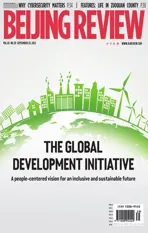Structural Reform Progress
2022-10-04ByLanXinzhen
By Lan Xinzhen

Structural changes in China’s supply chain over the past seven years have not only intensified the country’s economic resilience, but also promoted high-quality development. China’s economic landscape this year testifies to the merits of these reforms.
The Chinese economy slowed down during the March-May period, largely due to domestic COVID-19 flare-ups and deteriorating international conditions. Thanks to an array of stabilizing policies, economic growth began to bounce back in June and has since maintained an upward spiral.
Supply-side structural reform was first proposed in November 2015, enhancing the quality of supplies, correcting factor distortions and resource misallocations across the productivity spectrum of Chinese manufacturing firms and adapting the supply-side structure to changes in demand.
Before the idea was put on the table, the Chinese economy had already been plagued by new headaches: After 30 years of rapid growth,the pace was stagnating and the consumer price index (CPI) remained low. Residents’incomes increased a bit but corporate profit margins on the whole fell. Consumption was on the up, in stark contrast to ebbing investments. Conventional economic theories could no longer explain these paradoxical indexes.
The main challenge facing Chinese society became the gap between unbalanced and inadequate development and people’s growing aspirations for a better life.
With new economic challenges, troubles on the supply-side started hampering economic growth. But this was merely a structural glitch. With their mounting purchasing power,the Chinese people wanted better goods and services—some of which the market was able to offer,others it could not—resulting in a pressing need for supply-side structural reform.
For years, increasing demand by encouraging investment, consumption and export was the primary way to boost economic growth; from an economic perspective, these were all efforts on the demand side. Something had to be done on the supply side.
In the past seven years, supplyside structural reform has been the No.1 topic in government work reports, central economic work conferences, and other major economic conferences. The reform has taken place across aspects including industrial structure, regional structure, composition of factor inputs, income distribution, etc.
The Chinese economy’s performance this year proves that the decision to push forward supply-side structural reform was the right call.
Under this principle, the target to reduce excess steel-making and coal-producing capacities has been met, with a certain amount of outdated capacity and zombie companies,companies that need bailouts in order to operate, cut out. The market mechanism to determine factor allocation is now taking shape,ensuring a more balanced supply and demand structure.
Moreover, economic growth is increasingly driven by innovation, with major tech achievements springing up and the development of strategic emerging industries and modern service sectors accelerating. In the first eight months of this year, investments in hitech industries jumped by 20.2 percent year on year.
The economic structure keeps upgrading.According to the National Bureau of Statistics,the weight of the primary, the secondary and the tertiary industries in China’s GDP had been adjusted to 7.1, 39 and 53.9 percent, respectively, in the first half of this year from 15.2,51.2 and 33.6 percent in 2001. The sharply rising share of the tertiary industry constitutes a solid foundation for rapid and steady economic growth in coming years.
In recent years, a rising trend of unilateralism in international relations, together with the COVID-19 pandemic and geopolitical conflicts have seriously disrupted economic globalization, leading to sluggish global economic growth. Battered by so many blows, it’s crucial for China to press ahead with supplyside structural reform while trying to expand domestic demand. BR
